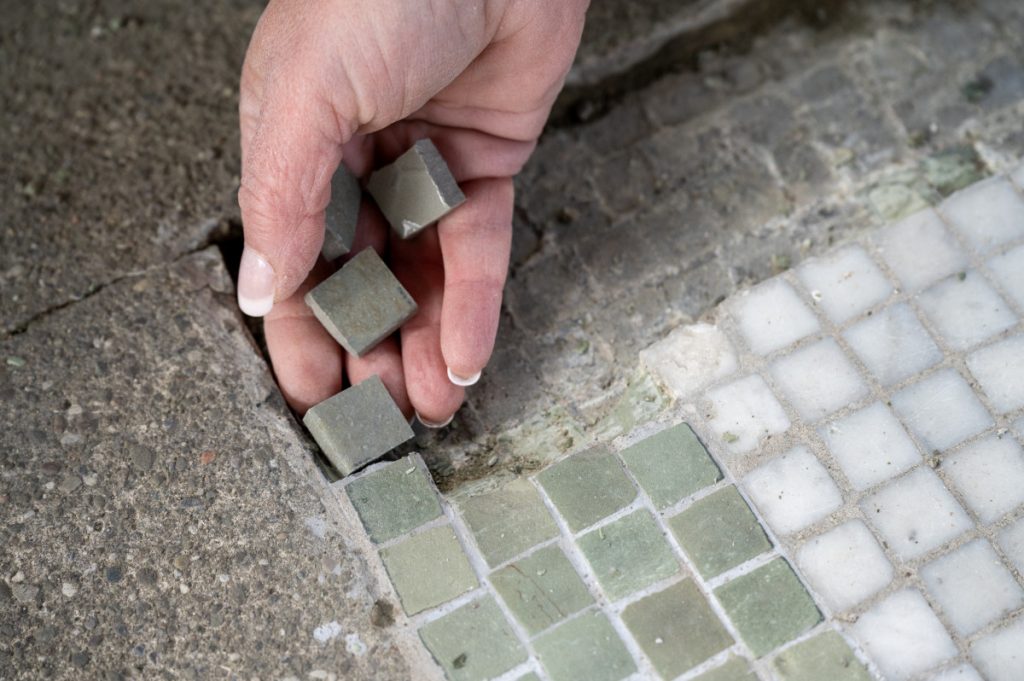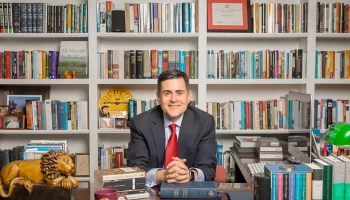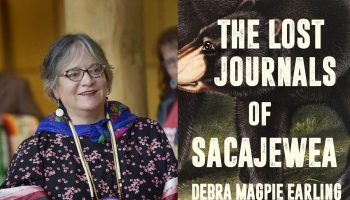
Denise Stebbins of Living Glass Gallery in Westfield, New York, works April 16 to remove damaged tiles from two mosaics in the Hall of Philosophy.
Karen Paul and Ryan Boughton first met only a year ago, but Paul now considers them to be “like best friends.”
This friendship was formed like many at Chautauqua throughout the Institution’s history: with a shared enthusiasm for the community found through the Chautauqua Literary and Scientific Circle.

Denise Stebbins checks the color and size match of newly-made replacement tiles used to restore the mosaics.
Paul, who serves as the vice president of the CLSC Class of 2000, and Boughton, the Institution’s capital projects manager, are leading the mosaic restoration project in the Hall of Philosophy, carefully assessing each tableau and determining what work needs done. The mosaics that edge the Hall of Philosophy are an important part of the CLSC’s history.
At its genesis, the CLSC was a four-year program, similar to that of a four-year college curriculum, created by Chautauqua co-founder John Heyl Vincent in 1878 with the dual purpose “to promote habits of reading and study in art, nature, science and in sacred and secular literature” and “encourage individual study, to open the college world to persons unable to attend higher institutions of learning,” according to the booklet “A Brief History of the CLSC.” The home reading circles spread; Institution President Arthur Bestor wrote that through the CLSC, Chautauqua “reached into innumerable towns, especially in the Midwest, and made education a powerful force in American life.”
For the thousands graduating from these reading courses, the CLSC was a point of pride; it still is to this day. The Hall of Philosophy mosaics, too, have been a point of pride for Chautauquans.
Many wedding guests, CLSC graduates and curious Chautauquans will have noticed the tiled pieces bordering the floor of the building modeled after a Grecian temple. Each of the 51 mosaics is marked with the name and year of a particular CLSC class and an image to represent it.
A class name, symbol and slogan are chosen democratically by members of that year’s graduating CLSC class. In 1882, the very first graduating class named themselves the Pioneers, alluding to their inaugural status, and chose a hatchet to represent their efforts “hatching their way through ignoramus,” as Paul uncovered in her research.
Among the mosaics, passersby will recognize the names of authors, prominent Chautauquans, literary references, and reactions to the changing world identifying the 51 classes represented on the Hall of Philosophy’s floor.
The mosaics are now over 100 years old, but sometimes their stories are even older.
“They’re referring to things hundreds of years old at that point, too,” Boughton said.
The Class of 1892 elected the name Columbia and the symbol of the Santa Maria to commemorate 400 years since Christopher Columbus crossed the Atlantic. The CLSC Class of 1918, the Arthurians, invoked the knights of the roundtable, while the CLSC Class of 1889 — the Argonauts — and the 1890 Pierians chose to reference Greek mythology, their tiled images laid at the foot of Chautauqua’s own neoclassical pillars.
But wear from high heels at weddings and water shoes in the summer alike loosened the tiles over the years to the point of hazard on some mosaics; others only need a fresh layer of sealant. Of the 51 mosaics, 37 need varying levels of re-tiling and repair.
The mosaic restoration project began in 2000, initiated by Tom H. Rowe, president of the CLSC Class of 2000, “now in heaven,” as Paul locates her Chautauqua friends and family who have passed.
Under Rowe’s leadership, the CLSC Class of 2000 created an endowment to help fund the repairs. Rowe oversaw the project for 17 years until his health began to deteriorate, at which point the Institution maintained the mosaics for the following seven years.
Boughton, who worked at the Bike Rent as a teenager, joined Chautauqua as a full-time staff member three years ago, and said it was around that time that Campus Planning and Operations considered “there might need to be an additional effort outside of the endowment monies because of the condition of a few of the mosaics that seemed like they needed extra attention.”
Thanks to fundraising efforts from Paul’s class and the Alumni Association of the CLSC, work was finally able to begin this spring,
For the repairs, Paul was recommended to the local artist Denise Stebbins, a retired art teacher and gallery owner in Westfield, and was immediately drawn to her work. Paul said she first saw the intricately tiled desk in Stebbins’ office and “it was like the sun shined in the windows and was like, ‘This is her! This is the lady! We have to hire her.’ ”
Upon meeting, the project managers learned Stebbins herself was married in the Hall of Philosophy, and her mother was an usher at the Amphitheater. Paul’s sun-washed discovery of Stebbins pulled in another collaborator with a long history at Chautauqua.
There were no records detailing the designers involved in the original mosaics. Paul deduced “you can see there were different artists because the numbers and the fonts change,” but that was the extent of what she could find on the artists.
Finding the materials was a similarly, if not more, arduous process than finding an artist. The lack of records led to a painstaking research process that involved scouring through and comparing materials to the weathered tiles until landing on the best match, determined through the eyes of Paul and Stebbins, and ultimately approved by Campus Planning and Operations. They looked everywhere, finding a direct tile match in Minnesota, and could finally start the restoration process in the spring of this year.
The first mosaics to be restored were those for the CLSC Class of 1919 and the CLSC Class of 1920, named America and the Optimists, respectively.
The America class began their studies in 1915 and graduated in 1919, witnessing the eruption and culmination of World War I in the duration of their studies. The Class of 1919 chose the white dove as their symbol and “Peace and Democracy” as their slogan. The values with which they represented their class were imbued with a national pride and moral affect generated during wartime. The Optimists’ slogan, “nothing less than the best,” gives insight to the national attitude heading into what would become the Roaring Twenties.
It took five weeks of diligent labor spent on her hands and knees for Stebbins and her husband, Darrell, to finish work on the two mosaics. Throughout these five weeks, the Stebbinses were subjected to a cool and wet Chautauqua spring. According to Paul, Stebbins would go home at the end of the day “so cold she had to sit in the hot tub.”
The care with which Paul approached the research of the project is matched in the details and dedication of Stebbins’ repairs. From hand-mixing the perfect type of paint, to removing larger sections of tile down to working in the minute details within intricate symbols, “she was very, very careful about her work,” Paul said. When possible, Stebbins was even able to reuse tiles from the mosaics.
The project is anticipated to take five years, with the majority of the mosaics left needing smaller repairs. After the tile work is complete, the mosaics will be resealed every two years going forward to prevent this level of disrepair from happening again. The CLSC Class of 2000’s endowment will continue to fund the sealant costs in the future.
Paul, a retired teacher, has curated an extensive mosaic archive that, until now, didn’t exist; through hours of research done with Scott Ekstrom, director of the Smith Memorial Library, and Jon Schmitz, the Institution’s archivist and historian, Paul and Boughton now have a centralized and complete set of records.
They’re the keepers of history now — what was not compiled 100 years ago is now carefully documented, and “Ryan’s going to have copies,” Paul quipped.
The two friends, longtime Chautauquans in both place and spirit, are in part motivated by the opportunity to continue compiling, documenting, and learning.
“It’s a pretty good magnifying glass to highlight different parts of the history,” Boughton said, referring to both the community that sustains Chautauqua, and the historicity naturally witnessed, studied and created by a 150-year-old institution.
“I love Chautauqua,” Paul said. “I’ve been here all my life, and I’m a Chautauquan.” She volunteered for the restoration project out of passion, fueled by love and memories, two points in their own circle.




